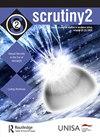冯内古特与启示录:库尔特·冯内古特对世界末日的再现
IF 0.1
0 LITERATURE
Scrutiny2-Issues in English Studies in Southern Africa
Pub Date : 2018-09-02
DOI:10.1080/18125441.2018.1546767
引用次数: 1
摘要
本文对库尔特·冯内古特的小说《猫的摇篮》(1963)进行了评析,并简要地参考了《屠宰场5》(1969),从这些虚构作品如何为我们提供了对世界末日事件的见解。冯内古特的作品最初是从生态批评的角度出发的,参考了Greg Garrard、Arne Naess和Val Plumwood的作品。还有一种关于天启的宗教观点,这反映在冯内古特的角色和叙事的发展中。此外,本文还借鉴了斯蒂芬·奥利里的理论,对启示录修辞进行了探讨。科学和科学家的角色,以及冯内古特是如何提出这一点的,也作为争论的一部分进行了调查。导致世界末日的事件构成了天启的一部分,冯内古特对这些事件的描述提供了对文学,科学和宗教试金石的关注的洞察力。本文章由计算机程序翻译,如有差异,请以英文原文为准。
Vonnegut and Apocalypse: A Consideration of Kurt Vonnegut's Representation of the End of the World
ABSTRACT This article comments on Kurt Vonnegut's novel Cat's Cradle (1963) and makes brief reference to Slaughterhouse 5 (1969) in terms of how these fictional works provide us with insights into apocalyptic events. Vonnegut's work is initially approached from an ecocritical perspective, referencing the work of Greg Garrard, Arne Naess, and Val Plumwood. There is also an engagement with religious views of apocalypse, which are reflected in Vonnegut's characters as well as the development of the narrative. In addition, the rhetoric of apocalypse is considered through reference to the theoretical work of Stephen O’Leary. The role of science and scientists, and how this is presented by Vonnegut, is also investigated as part of the argument. Events leading up to the end of the world constitute part of the apocalypse, and Vonnegut's depiction of these events provides insight into a concern that is a literary, scientific, and religious touchstone.
求助全文
通过发布文献求助,成功后即可免费获取论文全文。
去求助
来源期刊
CiteScore
0.50
自引率
0.00%
发文量
10
期刊介绍:
scrutiny2 is a double blind peer-reviewed journal that publishes original manuscripts on theoretical and practical concerns in English literary studies in southern Africa, particularly tertiary education. Uniquely southern African approaches to southern African concerns are sought, although manuscripts of a more general nature will be considered. The journal is aimed at an audience of specialists in English literary studies. While the dominant form of manuscripts published will be the scholarly article, the journal will also publish poetry, as well as other forms of writing such as the essay, review essay, conference report and polemical position piece. This journal is accredited with the South African Department of Higher Education and Training.

 求助内容:
求助内容: 应助结果提醒方式:
应助结果提醒方式:


